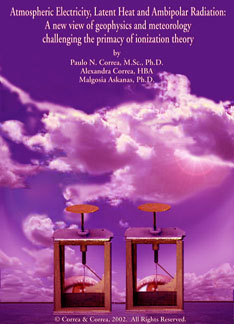|
ABSTRACT
The present communication compares and contrasts two views of atmospheric physics: one based upon ionization theory, the other upon Aetherometry. It also reviews the impact of Vol.s 1
and 2 of Experimental Aetherometry upon a reformulation of basic geophysical and
atmospheric processes.
Contents:
Introduction.
-
1. Does molecular work need to be considered in addressing the problem of the
spontaneous electroscopic discharge?
-
We argue that it does, and discuss how. The gravitational interactions of the
electroscope.
-
2. Cyclonic weather: can ions account for the electroscopic response to cloud
systems?
-
They cannot account for the equal acceleration of leakage and seepage observed
during the passage of clouds.
-
3. Anticyclonic weather: can ions account for the diurnal variations in electroscopic
discharge?
-
-
3a. Is there a correlation between the diurnal variation of the earth's electric
field or potential gradient, reported in the literature, and the diurnal pattern of
electroscopic discharge in anticyclonic weather?
-
Since leakage and seepage show the same basic pattern of diurnal
variation, this pattern cannot be caused by variations in the (negative) electric field of
the earth, but may rather serve as a clue towards explaining it.
-
3b. Do ion concentrations present characteristic diurnal variations in
anticyclonic weather?
-
The various diurnal patterns of varying concentrations of ions of
different classes are examined, along with the two fundamental ion concentration
patterns of fair weather days in the warm season.
-
3c. How do these findings regarding the diurnal variations of ion concentrations
affect the findings of Vol. 1 of Experimental Aetherometry?
-
The diurnal pattern observed for leakage and seepage of atmospheric
electroscopes in fair weather cannot be explained by the mass-spectrographic diurnal
patterns of air ion concentrations, neither in amplitude, nor by correlation with the
pattern of burst days. Determination of the ion fluxes and concentrations that would be
implied by the electroscopic observations is also carried out.
-
4. Is there covariation between increasing relative humidity during nighttime and
increasing concentrations of ions of both polarities? Between nighttime temperature
drops and ion concentrations? What of the relation between water evaporation and
latent heat?
-
We suggest that the only way to make sense of the relationship between the
electroscopic curve and %RH is by considering the higher environmental availability of
latent heat indirectly caused by the lowering of the dewpoint.
-
5. Can ion concentrations explain the soft correlation between high pressure and slow
electroscopic discharge rates?
-
The answer follows from the findings of Sections 2 and 3.
-
6. Can the deceleration and arrest of seepage and leakage inside ORACs and Faraday
cages be explained by mechanical ion blockage by the walls of these enclosures?
-
No. Encased and caseless identical electroscopes present the same rate of
discharge in spite of mechanical ion blockage by the case. And neither can the
observed discharge patterns inside ORACs and Faraday cages be accounted for by
mechanical ion blockage.
-
7. Positive demonstration of a gravitokinetic energy flux: photoinduced
antigravitokinetic regeneration with LFOT photons.
-
-
8. What are the actual main atmospheric effects of solar ambipolar and blackbody
radiations?
-
-
9. A better systematization of electroscopic processes.
-
-
10. What, then, is the source of the earth's electric field in fair weather? Can
anticyclonic days be exhaustively defined by monopolar charge parameters? What are
the roles of the latent and sensible heat byproducts of ambipolar radiation?
-
We suggest that monopolar mechanisms do not sufficiently explain these
phenomena, and that one must bring to bear upon them both non-electric factors and
massfree ambipolar interactions.
Conclusion.
|
![Akronos logo]](/images/akronos_wheel.jpg)
![Akronos logo]](/images/akronos_wheel.jpg)
